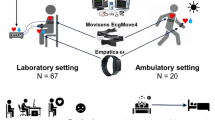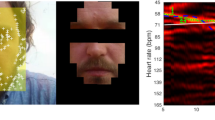Abstract
This paper describes a novel vibration sensing system with wide dynamic range for measuring “scratching”, “turning over” and “sitting up/lying down” motions in an unconstrained manner while the patient is sleeping. The sensing device used in the proposed system is composed of a piezoceramic sensor sandwiched between two metal plates. Under the system’s configuration, each piezoceramic sensor generates a measurable output voltage proportional to the wide-ranging amplitude of vibrations produced by “scratching”, “turning over” and “sitting up/lying down” motions. Furthermore, in order to detect the direction of “turning over” and “sitting up/lying down” motions, we defined two indices that could be calculated based on three output signals from the piezoceramic sensors placed under three legs of the bed. A validity experiment was carried out for comparison with a conventional sensing method for measuring “scratching”, “turning over” and “sitting up/lying down” motions. The results showed that the proposed vibration sensing system is valid in terms of accuracy without the need for attaching sensors to the patient’s body.








Similar content being viewed by others
References
Ebata T, Aizawa H, Kamide R, Niimura M (1999) The characteristics of nocturnal scratching in adults with atopic dermatitis. Br J Dermatol 141:82–86
Ebata T, Iwasaki S, Kamide R, Niimura M (2001) Use of a wrist activity monitor for the measurement of nocturnal scratching in patients with atopic dermatitis. Br J Dermatol 144:305–309
Izumi H, Ebata T, Sato Y, Aizawa H, Kamide R, Niimura M (1997) A simplified method for the measurement of nocturnal scratching with an infrared video camera. Skin 39:560–563
Umeda K, Noro Y, Murakami T, Tokime K, Sugisaki H, Yamanaka K, Kurokawa I, Kuno K, Tsutsui H, Nakanishi K, Mizutani H (2006) A novel acoustic evaluation system of scratching in mouse dermatitis: rapid and specific detection of invisibly rapid scratch in an atopic dermatitis model mouse. Life Sci 79:2144–2150
Kawabe Y, Aritake K, Noro Y, Umeda K and Mizutani H (2007) A study of sensors for detection of human scratching behavior during sleep. Tokai of society related to electricity branch union rally, O-329
Konishi M, Aritake K, Noro Y, Umeda K and Mizutani H (2008) A study of sensors for detection of human scratching behavior during sleep. Tokai of society related to electricity branch union rally, O-322
Yokoi H, Noro Y, Umeda K and Mizutani H (2008) Detection of human scratching behavior during sleep with acceleration sensor. Tokai of society related to electricity branch union rally, O-323
Felix R, Shuster S (1975) A new method for the measurement of itch and the response to treatment. Br J Dermatol 93:303–312
Savin AJ, Paterson DW, Oswald I (1973) Scratching during sleep. Lancet 302:296–297
Endo K, Sumitsuji H, Fukuzumi T, Adachi J, Aoki T (1997) Evaluation of scratch movements by a new scratch-monitor to analyze nocturnal itching in atopic dermatitis. Acta Derm Venereol (Stockh) 77:432–435
Aoki T, Kushimoto H, Hishikawa Y, Savin AJ (1991) Nocturnal scratching and its relationship to the disturbed sleep of itchy subject. Clin Exp Dermatol 16:268–272
Alihan J, Vaahtornanta V (1979) A static charge sensitive bed. A new method for recording body movement during sleep. Electroencephalogr Clin Neurophysiol 46:731–734
Ishijima M (1993) Monitoring of electro-cardiograms in bed without utilizing body surface electrodes. IEEE Trans Biomed Eng 40(6):593–594
Hernandez L, Waag B, Hsiao H, Neelon V (1995) New non-invasive approach for monitoring respiratory movements of sleeping subjects. Physiol Meas 16(3):161–167
Kirjavainen T, Cooper D, Polo O, Sullivan CE (1996) Respiratory and body movements as indicators of sleep stage and wakefulness in infants and young children. J Sleep Res 5(3):186–194
Rauhala E, Erkinjuntti M, Polo O (1996) Detection of periodic leg movements with a static-charge-sensitive bed. J Sleep Res 5(4):246–250
Tanaka S, Matsumoto Y, Wakimoto K (2002) Unconstrained and noninvasive measurement of heart-beat and respiration periods using a phonocardiographic sensor. Med Biomed Eng Comput 40:246–252
Watanabe K, Watanabe T, Watanabe H, Ando H, Ishikawa T, Kobayashi K (2005) Noninvasive measurement of heartbeat, respiration, snoring and body movements of a subject in bed via a pneumatic method. IEEE Trans Biomed Eng 52(12):2100–2107
Zhu X, Chen W, Nemoto T, Kanemitsu Y, Kitamura K, Yamakoshi K, Wei D (2006) Real-time monitoring of respiration rhythm and pulse rate during sleep. IEEE Trans Biomed Eng 53(12):2553–2563
Brink M, Mueller CH, Schierz C (2006) Contact-free measurement of heart rate, respiration rate, and body movements during sleep. Behav Res Methods 38:511–521
Mack DC, Patrie JT, Suratt PM, Felder RA, Alwan MA (2009) Development and preliminary validation of heart rate and breathing rate detection using a passive, ballistocardiography-based sleep monitoring system. IEEE Trans Inf Technol Biomed 13(1):111–1120
Watanabe K, Kurihara Y, Tanaka H (2009) Ubiquitous health monitoring at home -sensing of human bio-signals on flooring, on tatami mat, in the bathtub, and in the lavatory-. IEEE Sens J 9(12):1847–1855
Kortelainen JM, Mendez MO, Bianchi AM, Matteucci M, Cerutti S (2010) Sleep staging based on signals acquired through bed sensor. IEEE Trans Inf Technol Biomed 14(3):776–785
Nukaya S, Shino T, Kurihara Y, Watanabe K, Tanaka H (2012) Noninvasive bed sensing of human biosignals via piezoceramic devices sandwiched between the floor and bed. IEEE Sens J 12(3):431–438
Nukaya S, Sugie M, Kurihara Y, Hiroyasu T, Watanabe K, Tanaka H (2014) A noninvasive heartbeat, respiration and body movement monitoring system for neonates. Artif Life Robot 19(4):414–419
Sumi T, Nukaya S, Kaburagi T, Tanaka H, Watanabe K, Kurihara Y (2013) Development of scratching monitoring system based on mathematical model of unconstrained bed sensing method. Int J Med Health Biomed Pharm Eng 7(12):493–499
Kurihara Y, Kaburagi T, Watanabe K (2013) Development of a non-contact sensing method for scratching activity measurement. IEEE Sens J 13(9):3325–3330
Author information
Authors and Affiliations
Corresponding author
About this article
Cite this article
Kurihara, Y., Kaburagi, T., Watanabe, K. et al. Development of vibration sensing system with wide dynamic range: monitoring of scratching and turning-over motions during sleep. Artif Life Robotics 20, 372–378 (2015). https://doi.org/10.1007/s10015-015-0241-x
Received:
Accepted:
Published:
Issue Date:
DOI: https://doi.org/10.1007/s10015-015-0241-x




